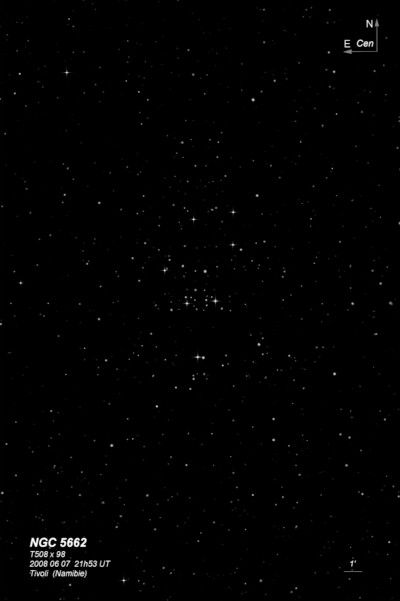
Nicolas-Louis de Lacaille discovered NGC 5662 = Lac III-8 = D 342 = h3573 in 1751-1752 with a 1/2" telescope at 8x during his expedition to the Cape of Good Hope. It was included in his 1755 catalogue as Class III No. 8. and noted as "two stars in nebulosity."
James Dunlop observed the cluster on 25 May 1826 and recorded "A group of small stars of the 11th and 12th mag, with a multitude of minute stars mixt, extended S.p. and N.f." His position was off by 9'. JH observed the cluster twice from the Cape. On 23 Apr 1835 he noted "large, p brilliant, coarse, sc cl of Class VII which more than fills the field; 50 stars more or less 9..12th mag; chief star 7th mag, somewhat insulated, taken for place of cluster." On a later sweep he logged "place of a red star, the chief and centre of a fine bright, but not rich cluster, of about 30 stars 9..13 mag. This red or high yellow star is 8th mag."
400/500mm - 18" (7/5/05 - Magellan Observatory, Australia): this cluster stands out well with the 27mm Panoptic (76x) with ~60 stars resolved in a 12'x9' region. The stars around the periphery are arranged in a distinctive concave pentagon similar to a court jester's crown. Includes three mag 9 stars as well as a number of mag 10.5-11 stars. The richest group of stars is on the SW side and includes a mag 9 luminary along with over a dozen stars within 3' including 5 or 6 of mag 10.5/11. The cluster is too large for a pleasing view at 228x. Situated a few arc minutes following orange-colored mag 7 HD 127753, which is isolated from the main group, though was given as the position of the cluster by John Herschel.
Notes by Steve Gottlieb